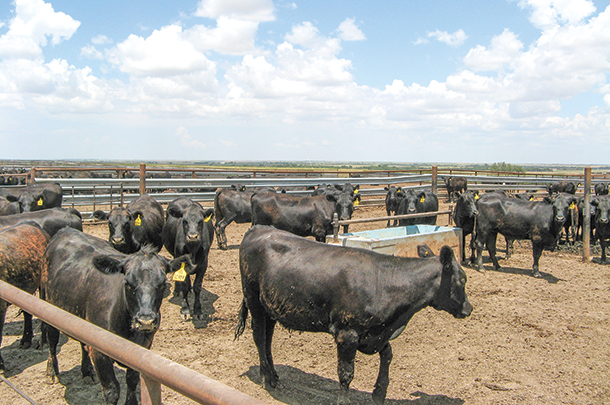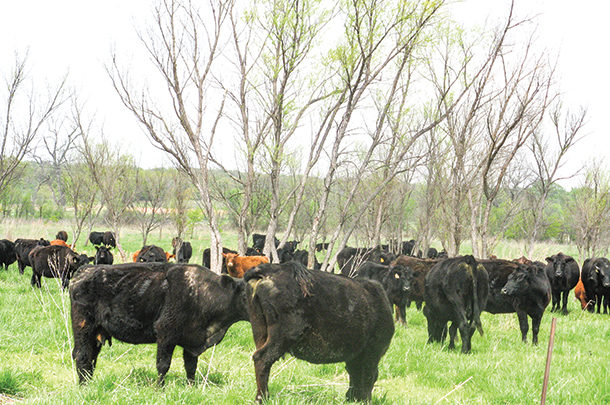The beef industry has responded to their concerns with development of marketing programs such as non-hormone-treated cattle (NHTC) in addition to natural, grass-fed, grass pastured and organic. Although there is no scientific evidence that suggests the need for these programs, they meet customer demand.
The USDA has created standards producers must meet to legally advertise and sell beef in each of these markets. Although the standards for each program is different, they all prohibit treatment with hormones.
“When bull calves are castrated, production of natural male hormones are reduced. These hormones cause bulls to grow faster, produce more muscle and protein, and deposit less fat than steers. Likewise, young heifers produce much less hormones than older or pregnant heifers,” says Dr. Dan Loy, Iowa State University Extension. “Administering small amounts of these or similar hormones (growth promotants) to steers and young heifers allows them to regain some of the growth rate produced by bulls and older heifers. The given amounts are a fraction of what is produced naturally by the animal.”
Currently, three types of products are used in the beef cattle industry to increase production efficacy – growth implants (hormones), ionophores and beta-agonists.
Growth implants, the most commonly used, are a small pellet inserted under the skin in the animal’s ear. The ear is used because it doesn’t enter the food supply. These implants dissolve slowly over a 100- to 120-day period while animals are in a feedyard. Loy says that depending on the type of implant and the age and sex of the animal, growth will improve from 10% to 20% and cost of beef production is reduced by 5% to 10% or more.
Ionophores are antimicrobials mixed with feed to improve feed efficiency and weight gain. They also reduce methane production, incidence of bloat and acidosis, and prevent diseases like coccidiosis. Beta-agonists are non-hormonal compounds that increase protein deposition, growth rate, feed efficiency and carcass leanness. They are fed at the end of the feeding period when muscle growth is slowing, fat deposition is increasing and feed efficiency is decreasing. Ionophores and beta-agonists can be used on NHTC, whereas growth implants cannot.
NHTC production
The NHTC concept originated in 1999 when the U.S. and European Union agreed to write control measures to facilitate a non-hormone- treated cattle trade. To qualify for the program, cattle are grown in approved farms, ranches and feedlots and delivered to the processor with an affidavit from the grower attesting they are non-hormone-treated. Non-treated cattle are segregated and handled in a manner to avoid co-mingling with other animals or meat. Tissue samples from non-hormone- treated cattle are collected at slaughter and analyzed by accredited independent laboratories for residual levels of restricted compounds. Additional USDA information on the NHTC program is found online (Non-hormone-treated cattle program).
Cow-calf producers must have an outside audit to qualify calves as NHTC prior to shipping. Non-hormone-treated cattle must have permanent identification such as electronic (EID), radio frequency (RFID) or visual identification tags. A producer-signed affidavit with identification of the USDA-approved, third-party provider responsible for the certification must accompany the shipment. Feedyards also have NHTC protocols to follow.

USA Feedyard, Gruver, Texas, feeds all types of cattle including NHTC and source and aged. “For us, feeding non-hormone-treated cattle requires a lot of extra effort and expense,” says Jeff Purvines, who manages the business. “We must use a separate feed truck for non-hormone-treated cattle and run a non-hormone-treated feed through it before use. NHTC cannot be placed in a pen next to heifers, so careful attention is paid to pen assignments. In addition to the extra labor required, there is also extra expense associated with the certifications and required paperwork. We also have to feed the cattle longer to obtain desired sale weights, which costs more money.”
Bonds Ranch, a large cow-calf producer headquartered at Saginaw, Texas, started a NHTC program working closely with the USDA before they approved third-party verifications. Today, they continue to work directly with USDA inspectors, rather than being audited by a third party.
“Our nutritional, health and management programs were developed to produce big, healthy calves with or without growth promotants. We expect at least a 10 percent weight reduction in our calves sold in the NHTC program, and the sales price has to make up the difference. Our programs have worked for us, and we will continue to use them,” says Missy Bonds.
Cattleman’s Choice Feedyard, Gage, Oklahoma, specializes in Global Animal Partnership (GAP), Verified Natural Beef (VNB) and NHTC. GAP is one of the largest animal welfare food-labeling programs in North America.
“Our programs are working for us because we work closely with the cow-calf operators who furnish our calves and the packers who process our beef. We all work as a team to keep our programs coordinated,” says Dale Moore, manager. “For success in the market, it is important for everyone on the feedyard staff to understand our programs and believe in them. This includes the cowboys, feed truck drivers, people running the feed mill, office staff and management.”
Is there value?
“At the present time, I don’t have a pen of NHTC on the yard,” says Purvines. “In addition, I’m not looking for NHTC to buy, because I can’t make money feeding them. There are some people making money feeding NHTC, but it’s not profitable for our organization.”
“We are in NHTC for the long haul,” says Missy Bonds, Bonds Ranch, Saginaw, Texas. “Some years we get a premium and some we don’t. With the new U.S. trade agreements with the European Union, marketing potentials for non-hormone-treated cattle are a lot brighter. The NHTC program was created, and continues to exist, only to meet the demands of the Europeans, so the amount of profit largely depends on currency exchange values.”
Cattleman’s Choice Feedyard is a 100% custom feeder where customers keep title to their cattle until they are sold to a processor. “We only feed program cattle [GAP, VNB and NHTC] and have a waiting list for incoming cattle,” says Moore. “Over the past ten years or so, we have not had a month where packer demand hasn’t outweighed the number of animals we could supply. The biggest benefit of the programs is the nice profits generated for the feedyard and our feeder customers in a very tight margin industry. We, and some of our feeders, were nearly broke several times prior to initiating our market niche programs. Now I have very few customers that will let me partner with them on a pen of cattle because of their potential profit.”
Several conclusions are derived from conversations with the interviewees. Before deciding to enter the NHTC business, a person should thoroughly study the market and required management style. For success, an established and coordinated supply chain involving the cow-calf producer, stocker operator, feeder and processor is important. There is a better chance of success if NHTC is a primary business objective. Above all, NHTC requires long-term commitment. ![]()
PHOTO 1: Brett Addison’s cows and calves near Marietta, Oklahoma, are grass-fed and receive only a clostridial vaccine during dehorning and castration.
PHOTO 2: Fed cattle at Premium Beef and Grain near Altus, Oklahoma, are in the natural beef program. Neither group of cattle are treated with any hormones. Photos by Robert Fears.
Robert Fears is a freelance writer based in Georgetown, Texas.









